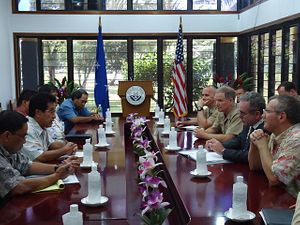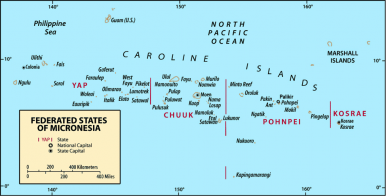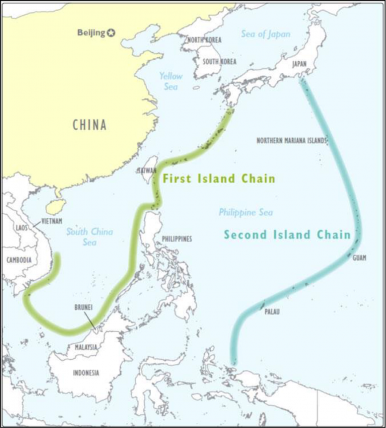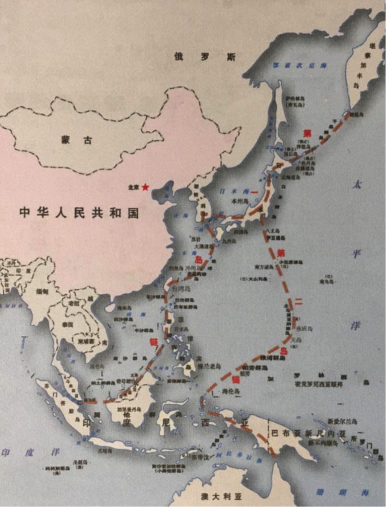In December 2015, in an oft overlooked corner of the globe, the Congress of the Federated States of Micronesia (F.S.M.) introduced a resolution* signifying the intent to end the Compact of Free Association with the United States of America in 2018. The two sides were in the process of discussing a potential renewal of the Compact when it expires in 2023.
While the rest of the world watches events in the South China Sea and the East China Sea, the People’s Republic of China is positioning itself to be in the driver’s seat in an area of key strategic interest to the United States. If Washington fails to act in a timely manner to renew the sometimes troubled Compact relationship, it will inadvertently drive the Micronesians into the arms of China and simultaneously leave a gaping hole in strategic access.
A Compact History: A Lesson in Complex Co-Dependency
The Compact of Free Association is a little known element of the complex web of relationships that spans the global interests of the United States of America. At the end of World War II, the United Nations established relationships between recently liberated Japanese Imperial holdings and the winning parties. As a result, the Trust Territories of the Pacific Islands (TTPI) were established by UN mandate (Security Council Resolution 21 signed July 18, 1947) and United States assumed responsibility for oversight. Throughout the 1950s and 1960s the U.S. developed and implemented the current civil code and mechanisms that are the basis of governance in the F.S.M. today. Beginning in the mid-1960s, moves towards autonomy in the region led to the establishment of the Commonwealth of Northern Marianas, Republic of Marshall Islands, Republic of Palau, and the Federated States of Micronesia.
The Federated States of Micronesia consists of four districts: Kosrae, Pohnpei, Chuuk, and Yap. All the districts consists of multiple islands and atoll groupings that represent in excess of 2,600,000 square kilometers of land and territorial waters with a population slightly more than 100,000 citizens located strategically in the western portion of the North Pacific Ocean east of the Republic of the Philippines and north of Papua New Guinea. Historically, these islands were called the Caroline Islands and they experienced some of the fiercest fighting of the Pacific Campaign during World War II.
Figure 1: Map of Federated States of Micronesia (www.fsmgov.org)
As a key feature of the Compact, the United States provides for the defense of F.S.M. This allows F.S.M. to free up important resources while maintaining a small constabulary force consisting of a small paramilitary force in the Division of Maritime Surveillance. As members of the Compact, Micronesians can freely join the U.S. military without permanent residency or citizenship. The agreement allows the U.S. to maintain strategic access to Lines of Communication that extend into the East China and South China Sea and beyond, waters that account for a majority of the trade and energy commodities transiting through Asia. With approximately one-third of global trade and nearly 50 percent of energy commerce passing through the region, it’s understandable why U.S. security interests maintain visibility on F.S.M.
Administration of the islands has been a source of tension between the local Micronesian people and the U.S. government since the establishment of the TTPI in 1947. The U.S. military (as administered by the U.S. Navy from Guam from 1947-1951) used many of the atolls in the region for open nuclear weapons testing, resulting in many diseases (cancer, birth abnormalities, and diabetes). In addition to the long-term health implications, continued resentment in the local populace remains below the surface.
The Department of the Interior is the current U.S. government agency that manages the Compact relationship with F.S.M. through the mechanisms of the Joint Economic Management Committee (JEMCO). JEMCO’s purpose is to “strengthen management and accountability with regard to the assistance provided under the Compact, as amended, and to promote the effective use of funding provided thereunder.” The JEMCO relationship provides for joint oversight of the Compact, but is viewed as being overly favorable towards the U.S. side of the relationship. The Compact agreement allows free movement of F.S.M. citizens to the rest of the U.S. with legal non-immigrant status. The majority of Micronesians migrate to Hawaii, Guam, American Samoa, and the Commonwealth of the Northern Marianas Islands. The associated costs with the arrangement weigh heavily on already limited budgets in the destination states and countries. The U.S. Congress has authorized increased funding in the budget over the last few fiscal years to address these impacts.
Both sides of the Compact relationship agree that there are economic, education, and healthcare concerns in F.S.M. It is solving those concerns where disagreement takes place, with Micronesians accusing the U.S. government of mismanagement and being too slow with development aid. The Department of the Interior’s Office of Insular Affairs in Honolulu also recognizes the unique set of challenges to F.S.M. and its neighbors and recently provided recommendations to Congressional leaders on how to address the concerns: “1) Addressing Freely Associated States (FAS) Out Migration 2) Improved coordination of Current Federal Programs and Funds 3) Establishment of Micronesian One-Stop Service Centers and 4) Establishing a Federal Interagency Group on Compact Impact Aid.”
Ending the Compact: Say What?
Although the Compact of Free Association with the Federated States of Micronesia is scheduled to expire in 2023, the process for renegotiating the relationship with the United States has been ongoing throughout the agreement’s history. The most recent amendment to the agreement took place in 2003 with the passing of Public Law 108-188 by the 108th U.S. Congress. This highlights the ability to periodically go back and address policy and implementation concerns. The move to end the Compact in 2018 is not only five years early, it disrupts the funding of programs that are mandated through a 15-year provision cycle. In the current amended agreement, annual mandatory financial assistance is scheduled to end in 2023 and be replaced with a general trust fund. The Trust Fund was established and continues to report annually in accordance with the amended 2003 Compact.
Ending the Compact in 2018 impacts F.S.M. more than it does the U.S. For one thing, Micronesians currently living abroad will lose their immigration status and face a potential loss of federal benefits already being provided. In F.S.M.s view, the ending of the Compact provides an opportunity to redefine the relationship with the U.S. and set things on a more equal footing, replacing the existing junior-senior partner relationship with one between two independent sovereign nations. The most serious impact from the U.S. standpoint is in the provision of security and defense for F.S.M. If that is not provided by the United States, who then would be the guarantor of Micronesian security? This is where the People’s Republic of China enters the picture.
China’s Growing Influence and the Second Island Chain Strategy
At a time when news on the South China Sea disputes and the tensions in the East China Sea dominates the 24 hour news cycle, the growing Chinese influence in the Pacific islands seems to go generally unnoticed. However, Beijing’s growing presence has become of significant concern to many nations, including the U.S., Australia and New Zealand. The influence is generally low key, taking the form of a “soft power” approach that provides economic and developmental aid with “no strings attached.” As the investment and aid eclipses that provided by the U.S. and others in the region, Chinese influence carries more weight, including in foreign policy decisions, such as negotiations over the Compact of Free Association with F.S.M. Through numerous large-scale infrastructure investments (many of which are of questionable quality), small-scale programs and organizations, as well as the construction of Official Residences, the Chinese have demonstrated “a stark (difference) as the U.S. clearly and openly begun a process of decreased funding…leading to the end of the major bilateral agreement between it and the FSM.” Although concerns such as these were highlighted almost 10 years ago, Chinese investment is more noticeable now than ever. Overseas Developmental Assistance (ODA) from China has increased steadily since 2003, from minimal amounts to an officially reported total of $28 million. Anecdotal information estimates that the actual figure could be as much as three to four times higher. Reports of numerous trips by F.S.M. Congressional leaders to China only exacerbate the perceptions of influence and a reluctance to engage the U.S.
Despite the relatively benign view of investment by the Chinese in F.S.M., the issues of maritime security and strategic access provide more cause for concern. With the ending of the Compact, the U.S. could potentially lose free access to the strategic lines of communication that connect the Pacific Ocean to the vital traffic of the East and South China Seas. Yet, there’s more in the context of China’s grand strategy involving the Second Island Chain and methods to stop intervention (called “counter-intervention” in Chinese military literature) in defending China’s maritime periphery. The Second Island Chain refers to a element of China’s strategy that involves maintaining its maritime security interests in a tiered perspective.
Figure 2: Island Chains as depicted in 2012 US DoD China Military Report
Figure 3: Island Chains as depicted in 2012 People’s Liberation Army-Navy Report
Possession of portions of the Second Island Chain allows China to become “springboards against foreign force projection.” Restricting access to these regions, such as F.S.M., supports Chinese military and national strategy goals. In the regional view of security, when tied to the Island Chain concepts, F.S.M. fits neatly into a number of jigsaw puzzle pieces that are falling into place for China in securing its national interests.
Security Implications: Why the US and Others Should Care…
While the time and attention of policymakers is focused rightly on the events taking shape in the East China Sea and South China Sea, there is another significant security issue that requires a focused effort from U.S. national decision makers. If F.S.M. were to gracefully fall into the long-term sphere of Chinese influence, the ramifications would be tremendous. Some will look at this issue as if the Micronesians are artfully coercing the United States into a sweeter long-term deal. However, if we understate the implications, then the U.S. will face a shift in regional security that leaves nearby Guam at risk and other key allies in the region with much more to think about regarding the relationships with the U.S.
In the case of other national interests in the region, just as China views itself being encircled, imagine the Philippines’ perception with strategic access potentially being cut off to its immediate west, eventual reintegration of Taiwan into mainland China to its north, and strategic access restricted to a newly changed situation directly to its east. Encircled? Yes.
The same dilemma will face other actors in the region such as the Association of South East Asian Nations (ASEAN), Japan, South Korea, and all the way to India and Europe. Limited strategic access for trade, resources, and military response will be made even more difficult by forcing interested countries to use longer lines of communication that add days and weeks that will be reflected in higher costs for material goods.
The Compact of Free Association needs more time and attention before the agreement terminates in 2018. The U.S. needs to prioritize efforts to ensure that security interests long term are not adversely impacted.
Lieutenant Colonel Tom Matelski is a U.S. Army War College Fellow at the Daniel K. Inouye Asia Pacific Center for Security Studies. The views expressed in this article are those of the author and do not necessarily reflect the official policy or position of the U.S. Army War College, the U.S. Army, the Daniel K. Inouye Asia Pacific Center for Security Studies, the Department of Defense, or the U.S. Government.
*Corrected. The resolution has only been introduced, and has not yet passed.




































